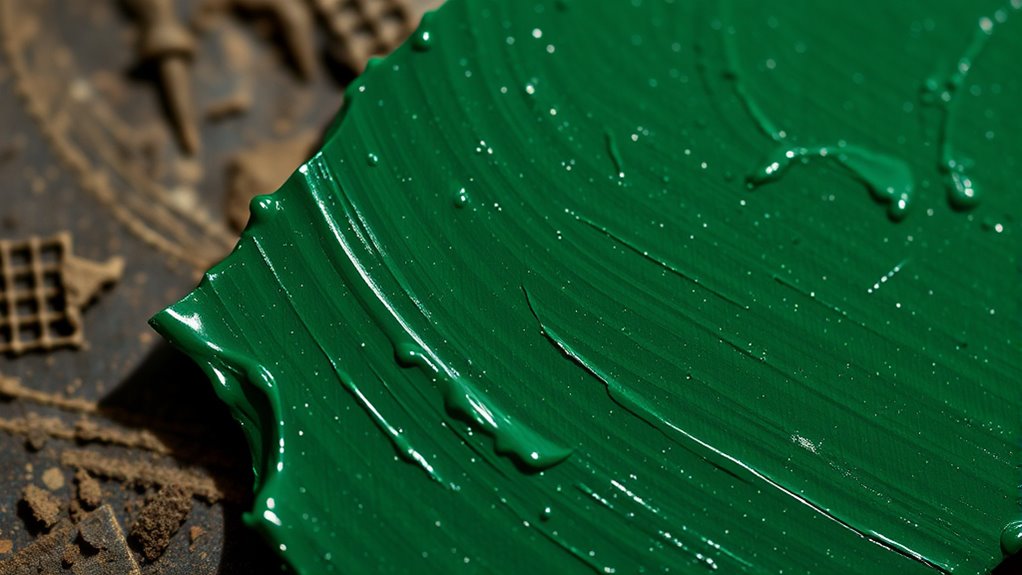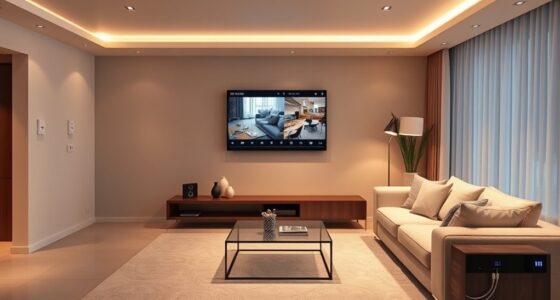Your favorite paint shade reveals more about your personality than you might think. Warm colors like reds and oranges suggest you’re energetic, passionate, or seek excitement. Cool hues such as blues and greens indicate a calm, introspective nature and a love for peaceful environments. Whites and neutrals reflect sophistication, organization, or simplicity, while jewel tones show confidence and boldness. If you want to uncover more about what your color choice says about you, keep exploring these deeper meanings.
Key Takeaways
- Warm shades like red and orange suggest a lively, energetic personality and a desire for comfort and social connection.
- Cool colors such as blue and lavender reflect calmness, introversion, and a preference for peaceful, relaxing environments.
- Neutral tones like gray, black, and white indicate sophistication, emotional restraint, and a value for simplicity and balance.
- Jewel tones like emerald and sapphire reveal confidence, luxury, and an outgoing, bold personality.
- The specific hue and saturation level can reveal underlying traits, from a need for control to a desire for warmth or tranquility.
The Emotional Significance of Warm Colors

Warm colors like red, orange, and yellow are more than just eye-catching; they actively influence your emotions. In color psychology, these hues carry emotional significance rooted in their connection to the sun, fires, and nature’s coziness. When used in interior design, warm colors can be stimulating, energizing social interactions and increasing appetite, making them perfect for dining or gathering spaces. They evoke feelings of happiness, comfort, and vitality, creating a cozy environment that encourages intimacy. Additionally, understanding the sound design principles behind creating ambient atmospheres can help enhance the emotional impact of these colors in your space. Incorporating color psychology insights can also guide you in selecting shades that promote desired moods and behaviors. However, using too much saturated warm color can overwhelm or cause agitation, so balance is key. Recognizing the vetted – ID Times for color choices can help you select hues that foster positivity and warmth in your space, enhancing your mood and making your environment feel more inviting. Additionally, awareness of city dynamics can help tailor your space to better suit your social environment and lifestyle, and incorporating zodiac compatibility insights can deepen your connection to personal spaces and relationships.
The Calming Effect of Cool Hues

Cool hues like pale blues, lavenders, and greens are known for their tranquil and soothing qualities, making them ideal choices when you want to create a peaceful environment. These soothing colors promote relaxation and help reduce stress, fostering a sense of serenity. Inspired by natural elements like water and sky, they encourage a peaceful atmosphere in any space. Additionally, incorporating AI-driven personalization techniques in interior design can help tailor color schemes to individual preferences, enhancing the calming effect. Understanding cybersecurity principles can also inform how environments are designed to protect mental well-being from digital stressors. They can lower blood pressure and heart rate, enhancing well-being. Pale blue and green tones are perfect for bedrooms and meditation areas. Adding hints of yellow or brown balances the coolness and prevents sterility. These shades support mental clarity and restful sleep. Incorporating soundscapes or gentle background noises can further amplify the calming environment, creating a more immersive experience, especially when aligned with harmony in design. For example, selecting appropriate lighting can complement these hues and deepen the sense of tranquility.
What Whites Say About Your Style
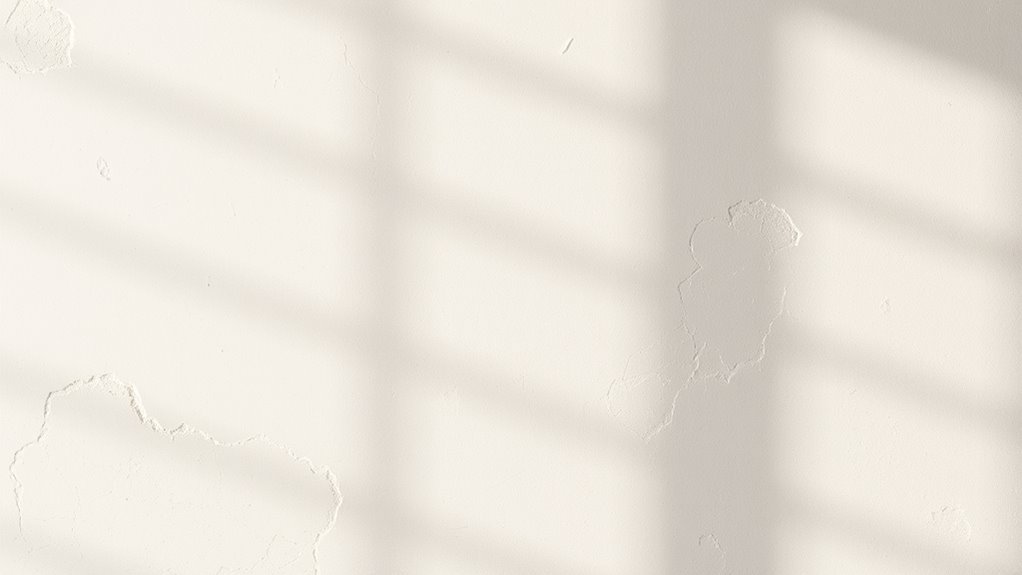
Your choice of white paint reveals a lot about your style. Whether you prefer warm or cool tones, it shows if you value cleanliness, organization, or modern simplicity. Whites serve as a blank slate that highlights your personality and taste. Additionally, understanding color psychology can help you select shades that evoke specific moods and complement your overall decor. Recognizing relationship dynamics can also influence how you choose and display your space, reflecting your approach to connection and harmony. Incorporating visual perception insights can further refine your color choices to create a desired atmosphere, and awareness of low light office plants can add subtle elegance to your environment.
Cleanliness and Organization
Choosing white in your interior design often signals a love for cleanliness and organization. It shows you value a tidy, clutter-free space that promotes mental calmness. White creates a neutral backdrop that highlights order and simplicity, reflecting a personality that appreciates neatness. Warm white tones suggest comfort and warmth, while icy blues emphasize crispness and clarity. Your preference for white indicates a desire for control and a well-maintained environment. Additionally, high-quality materials used in white decor can further reinforce a sense of sophistication and durability. Engaging in mindful decluttering can help sustain the clean aesthetic and prevent clutter from accumulating over time. Moreover, understanding signs of spoilage in products like lemon juice can help maintain a fresh and pristine environment in your home, especially as automation in business increasingly influences household management practices. Recognizing angel number soulmate signs can also provide insight into your personal relationships and emotional well-being.
Versatility and Clarity
White shades in interior design showcase a remarkable versatility that can adapt to various styles and atmospheres. Whether you prefer warm parchment tones or icy blue hues, white instantly communicates clarity and openness. Crisp, pure whites reflect a minimalist, organized vibe, emphasizing cleanliness and simplicity. Softer whites add warmth and friendliness, while cooler whites suggest sophistication and modernity. This versatility allows white to serve as a neutral backdrop, highlighting other colors and design elements effortlessly. Your choice of white reveals your desire for order, purity, and a clean aesthetic. Additionally, understanding the emotional support that color choices can provide helps create spaces that foster comfort and well-being. Recognizing the regional differences in color preferences can help tailor your design to your local environment and cultural context. Incorporating attention into your design process enhances your ability to select shades that resonate with your personal style and emotional needs. Exploring different color palettes can further enrich your interior environment, making it more dynamic and personalized.
The Glamour and Confidence of Jewel Tones
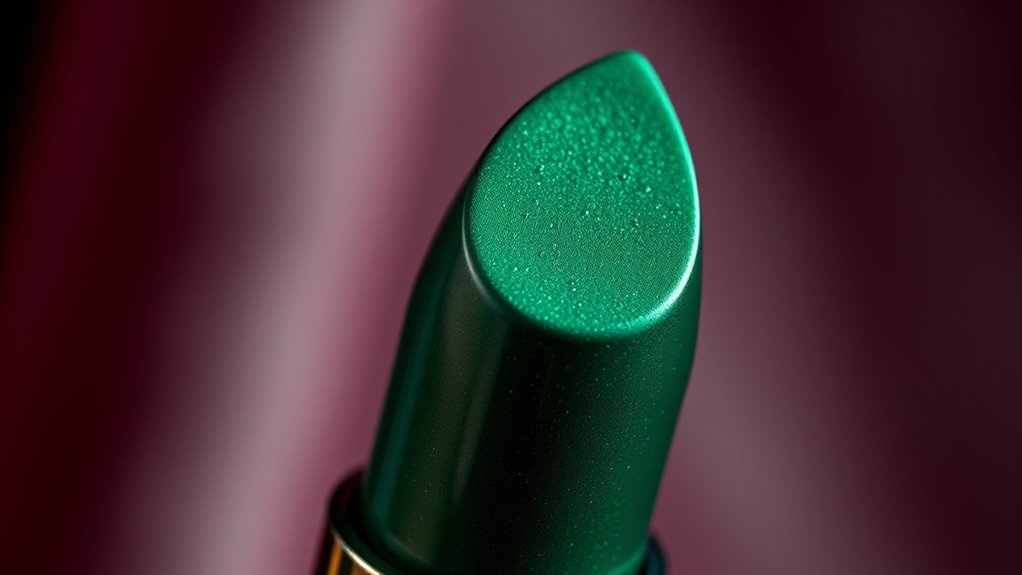
Jewel tones like ruby red, emerald green, sapphire blue, amethyst purple, and topaz yellow instantly evoke a sense of glamour and sophistication. These rich hues exude luxury and boost confidence, making them perfect choices for interior design and fashion. Incorporating jewel tones can minimize imperfections in a space, creating a lavish atmosphere or eye-catching accent walls. They effortlessly add depth and visual interest when paired with neutrals or similar intense shades. Wearing or decorating with these colors signals an outgoing personality and a desire to stand out. Plus, jewel tones enhance positive feelings, making you feel more self-assured and stylish.
- Convey confidence and personality
- Elevate luxury in any setting
- Create bold, enthralling spaces
- Inspire positive emotions
Blues as a Reflection of Serenity and Introversion

When you choose blue shades for your space, it often signals a desire for calm and reflection. These colors create an environment that promotes relaxation and emotional stability, aligning with introverted tendencies. By embracing blue, you may be seeking serenity and a retreat from overstimulation.
Tranquil Space Choice
Have you ever noticed how blue shades can instantly create a sense of calm and retreat from chaos? When you choose blue for your space, you’re embracing a color associated with serenity and tranquility. This hue fosters a peaceful atmosphere that promotes calmness and emotional stability. People drawn to blue often seek organized, harmonious environments that reflect their conscientious nature. The psychological effects of blue paint include lowering heart rates and reducing stress, making it ideal for quiet retreats. Blue also symbolizes trust and stability, aligning with introverted tendencies to value solitude and reflection. Whether for a bedroom or a meditation corner, blue transforms your space into a tranquil haven, supporting your need for peaceful, introspective moments.
- Promotes calmness and reduces stress
- Reflects a desire for stability and trust
- Fosters organized, harmonious surroundings
- Creates a peaceful, serene environment
Reflects Calm and Introversion
Blue shades naturally mirror a sense of calm and introspection, making them a popular choice for those who value peaceful environments. When you choose blue, you’re embracing a color that promotes relaxation and emotional safety. These shades often reflect introversion, attracting individuals who prefer solitude or quiet activities over social gatherings. The psychological impact of blue includes reducing stress and fostering a tranquil mindset, aligning perfectly with your desire for calm surroundings. Spaces painted in blue are frequently selected for reflection or concentration, emphasizing a serene atmosphere. If you feel drawn to blue hues, it likely signals your appreciation for peaceful environments and a thoughtful, introspective nature. Ultimately, blue shades serve as a visual cue of your inner calm and preference for a quiet, soothing space.
The Personality Insights From Neutral Shades

Neutral shades like beige, gray, and taupe reveal a personality that values simplicity, balance, and harmony. When you choose these versatile colors, you often seek calm spaces that promote relaxation and focus. Your preference for neutral tones offers personality insights into someone who appreciates understated elegance and practicality. You tend to be organized and adaptable, prioritizing functionality over bold expression.
Neutral tones reflect a calm, organized, and practical personality that values elegance and harmony.
- You favor calm environments that foster peace and clarity
- Your style reflects timeless elegance and subtlety
- You value versatility in colors, matching various decor styles
- Your personality leans toward patience, introversion, and mindfulness
In essence, neutral shades highlight a desire for understated sophistication and a peaceful, balanced life.
The Power and Passion of Red and Its Variations
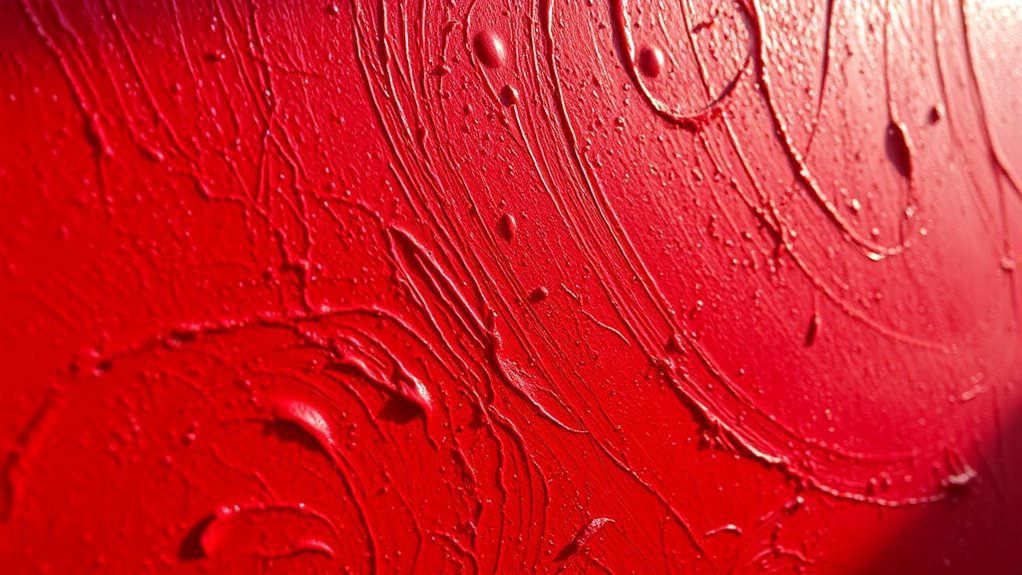
Red and its variations hold immense power to evoke passion, energy, and urgency in a space. When you choose red, you’re tapping into a color that stimulates emotion and ignites desire, making it perfect for creating a lively atmosphere. Variations like burgundy or crimson add sophistication and authority, depending on their saturation and context. Red naturally increases heart rate and blood pressure, boosting motivation and alertness. Psychologically, this color is associated with love, desire, and attention, making it ideal for spaces meant to inspire excitement or intimacy. However, overusing red can lead to feelings of irritability or hostility, illustrating its potent influence on mood and behavior. Its versatility allows you to craft environments that provoke strong emotional responses, from passion to power.
The Subtle Messages Behind Gray and Black
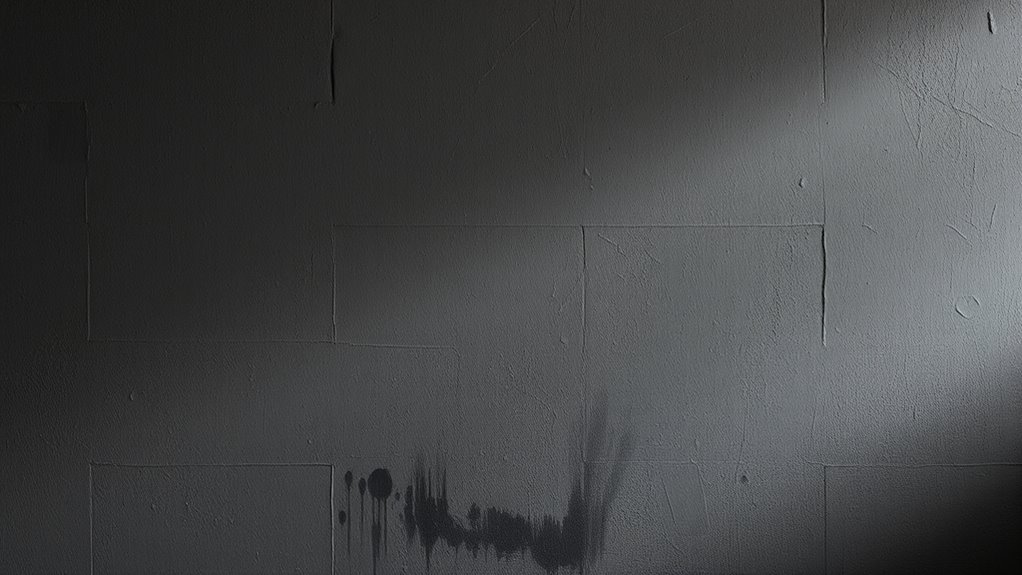
Gray and black communicate subtle yet powerful messages about your personality and the spaces you choose. These colors carry deep interior design and color meanings that reveal your desire for sophistication and emotional restraint. Gray often symbolizes neutrality, balance, and professionalism, reflecting a need for stability. Black signifies power, elegance, mystery, and independence, highlighting confidence and a preference for privacy. Both shades convey understated messages, suggesting you value discretion and control.
Gray and black subtly express sophistication, emotional restraint, and a desire for control in your personal space.
- Gray creates a sense of calm and timeless style in your space.
- Black adds depth, drama, and a touch of authority.
- These colors evoke emotional impact through their understated sophistication.
- Personal choices in gray or black may reveal traits of formality and emotional protection.
Frequently Asked Questions
What Do the Colors of Paint Mean?
Colors of paint carry powerful meanings and evoke emotions. When you choose blue, you might seek calm or trust, while red can energize or stimulate passion. Green often symbolizes nature and balance, and purple suggests luxury or creativity. Warm shades like yellow and orange boost happiness, whereas cool tones like lavender promote relaxation. Your choice reflects your mood or intentions, as colors connect deeply with feelings and cultural symbolism.
What Does Purple Mean in a Bedroom?
Purple in your bedroom blends luxury with tranquility, creating a space that’s both opulent and calming. You might feel inspired and introspective, as this color stimulates your imagination while promoting emotional balance. Lighter shades like lavender bring relaxation, perfect for unwinding, while deeper purples add sophistication and depth. Your choice reflects a desire for a peaceful retreat that nurtures creativity, making your room a sanctuary for both rest and inspiration.
What Does Painting a Room Blue Mean?
When you paint a room blue, you’re creating a space that promotes calmness and mental clarity. Light blues suggest trust, openness, and a welcoming vibe, making your room feel more inviting. Deep navy shades add sophistication but can sometimes make social interaction feel a bit distant. Overall, blue helps reduce stress and encourages relaxation, so you’re likely aiming for a peaceful, focused environment that enhances your well-being.
What Does “White in the Bedroom” Mean?
When you choose white for your bedroom, it often reflects your desire for purity, peace, and simplicity. You prefer a clean, neutral space that feels calm and spacious, helping you clear your mind. Warm whites make your room cozy, while cooler whites add freshness. Your choice suggests you value organization, tranquility, and a retreat from chaos, creating a bright, inviting environment that promotes relaxation and clarity.
Conclusion
Your favorite paint shades reveal more about you than you realize. Warm tones might suggest your vibrant personality, while cool hues could hint at your calm nature. Reds spark passion, and neutrals show your balanced side. Think of color as a visual language, speaking volumes about your inner world. By understanding these hidden meanings, you can choose shades that truly reflect who you are—and maybe even influence how others see you.
